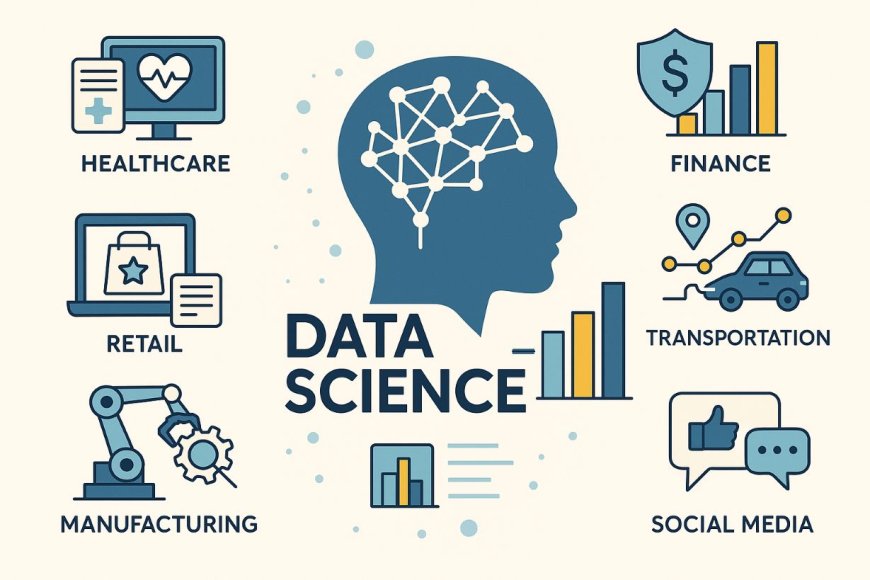Data Science in Action: Real-World Applications and Case Studies
Discover how data science drives real-world innovation across industries. Explore case studies in healthcare, finance, retail, and more, showcasing predictive analytics, fraud detection, personalized recommendations, and AI-powered solutions.

Introduction
Data science has emerged as one of the most transformative fields of the 21st century, driving innovation across industries. By leveraging statistical analysis, machine learning, and big data technologies, organizations can extract actionable insights, optimize operations, and make data-driven decisions.
This article explores real-world applications of data science, highlighting its benefits through case studies from healthcare, finance, retail, transportation, and more.
1. Healthcare: Predictive Analytics for Early Disease Detection
Application:
Hospitals and research institutions use data science to predict disease outbreaks, personalize treatments, and improve patient outcomes. Machine learning models analyze electronic health records (EHRs), genetic data, and imaging scans to detect early signs of diseases like cancer, diabetes, and heart conditions.
Case Study: IBM Watson for Oncology
IBM Watson uses natural language processing (NLP) and machine learning to analyze medical literature and patient records, assisting oncologists in recommending personalized cancer treatments. At Memorial Sloan Kettering Cancer Center, Watson helped reduce diagnosis time and improved treatment accuracy by cross-referencing thousands of research papers and clinical trials.
Benefits:
· Faster and more accurate diagnoses
· Personalized treatment plans
· Reduced healthcare costs through preventive care
2. Finance: Fraud Detection and Risk Management
Application:
Banks and financial institutions deploy data science to detect fraudulent transactions, assess credit risk, and automate trading. Machine learning models analyze transaction patterns in real time to flag anomalies.
Case Study: PayPal’s Fraud Detection System
PayPal processes billions of transactions daily, making fraud detection critical. Using deep learning and anomaly detection algorithms, PayPal reduced false positives by 50% and increased fraud detection accuracy. Their models analyze user behavior, location, and transaction history to identify suspicious activity.
Benefits:
· Minimized financial losses due to fraud
· Enhanced customer trust and security
· Automated risk assessment for loans and investments
3. Retail: Personalized Recommendations and Inventory Optimization
Application:
E-commerce giants like Amazon and Netflix use recommendation systems to suggest products and content based on user behavior. Retailers also optimize inventory and pricing using demand forecasting models.
Case Study: Amazon’s Recommendation Engine
Amazon’s recommendation system accounts for 35% of its total sales. By analyzing browsing history, purchase patterns, and customer reviews, machine learning models generate personalized product suggestions, increasing customer engagement and sales.
Benefits:
· Higher conversion rates and customer retention
· Reduced inventory waste through demand forecasting
· Dynamic pricing strategies for maximizing profits
4. Transportation: Route Optimization and Autonomous Vehicles
Application:
Companies like Uber, Lyft, and Tesla use data science to optimize routes, reduce fuel consumption, and develop self-driving cars. Predictive models analyze traffic patterns, weather conditions, and historical trip data.
Case Study: UPS’s ORION System
UPS implemented the On-Road Integrated Optimization and Navigation (ORION) system, which uses advanced algorithms to determine the most efficient delivery routes. This reduced fuel consumption by 10 million gallons annually and saved over $400 million per year.
Benefits:
· Lower operational costs and fuel consumption
· Reduced delivery times
· Enhanced safety in autonomous driving systems
5. Manufacturing: Predictive Maintenance and Quality Control
Application:
Manufacturers use IoT sensors and machine learning to predict equipment failures before they occur, minimizing downtime. Computer vision models also inspect product quality in real time.
Case Study: General Electric (GE) and Predictive Maintenance
GE uses sensor data from jet engines, wind turbines, and industrial machines to predict failures. Their Predix platform analyzes real-time data to schedule maintenance proactively, reducing unplanned downtime by up to 20%.
Benefits:
· Increased equipment lifespan
· Reduced maintenance costs
· Improved production efficiency
6. Social Media: Sentiment Analysis and User Engagement
Application:
Platforms like Facebook, Twitter, and LinkedIn use NLP and sentiment analysis to understand user emotions, detect harmful content, and improve ad targeting.
Case Study: Twitter’s Hate Speech Detection
Twitter employs machine learning models to detect hate speech and abusive content in real time. By analyzing text patterns and user reports, these models automatically flag or remove harmful tweets, improving platform safety.
Benefits:
· Enhanced user experience and brand reputation
· Efficient content moderation at scale
· Better-targeted advertising through sentiment insights
Conclusion
Data science is revolutionizing industries by turning raw data into actionable intelligence. From healthcare to finance, retail to transportation, organizations are leveraging predictive analytics, machine learning, and AI to solve complex problems, enhance efficiency, and drive innovation.
As data continues to grow in volume and complexity, the role of data science will only expand, unlocking new possibilities for businesses and society.
Key Takeaways:
- Healthcare: Early disease detection and personalized medicine
- Finance: Fraud prevention and automated risk assessment
- Retail: Personalized recommendations and inventory optimization
- Transportation: Route efficiency and autonomous vehicles
- Manufacturing: Predictive maintenance and quality control
- Social Media: Sentiment analysis and content moderation
By adopting data science, organizations can stay competitive, improve decision-making, and create a smarter, data-driven future.
Written/published by Kevin Marshall with the help of AI models (AI Quantum Intelligence)













